Financial Accounting Analysis: D&G Company Transactions and Accounts
VerifiedAdded on 2021/05/20
|33
|6609
|679
Report
AI Summary
This report, prepared for the HCMC University of Technology and Education, analyzes the financial accounting practices of D&G Company. It begins with an introduction to the accounting cycle, detailing its five steps: source documents, journals, ledgers, trial balance, and final accounts. The report applies the double-entry bookkeeping system, demonstrating the recording of business transactions in journal entries and T-accounts. It then proceeds to the preparation of a trial balance and explains its purpose. Furthermore, the report covers the preparation of final accounts, including the profit and loss account and balance sheet, adjusting for accruals, depreciation, and prepayments. The assignment includes examples and calculations based on a provided scenario, illustrating the practical application of accounting principles for sole traders, partnerships, and limited companies. The report concludes with a discussion of the overall financial accounting process and its importance.
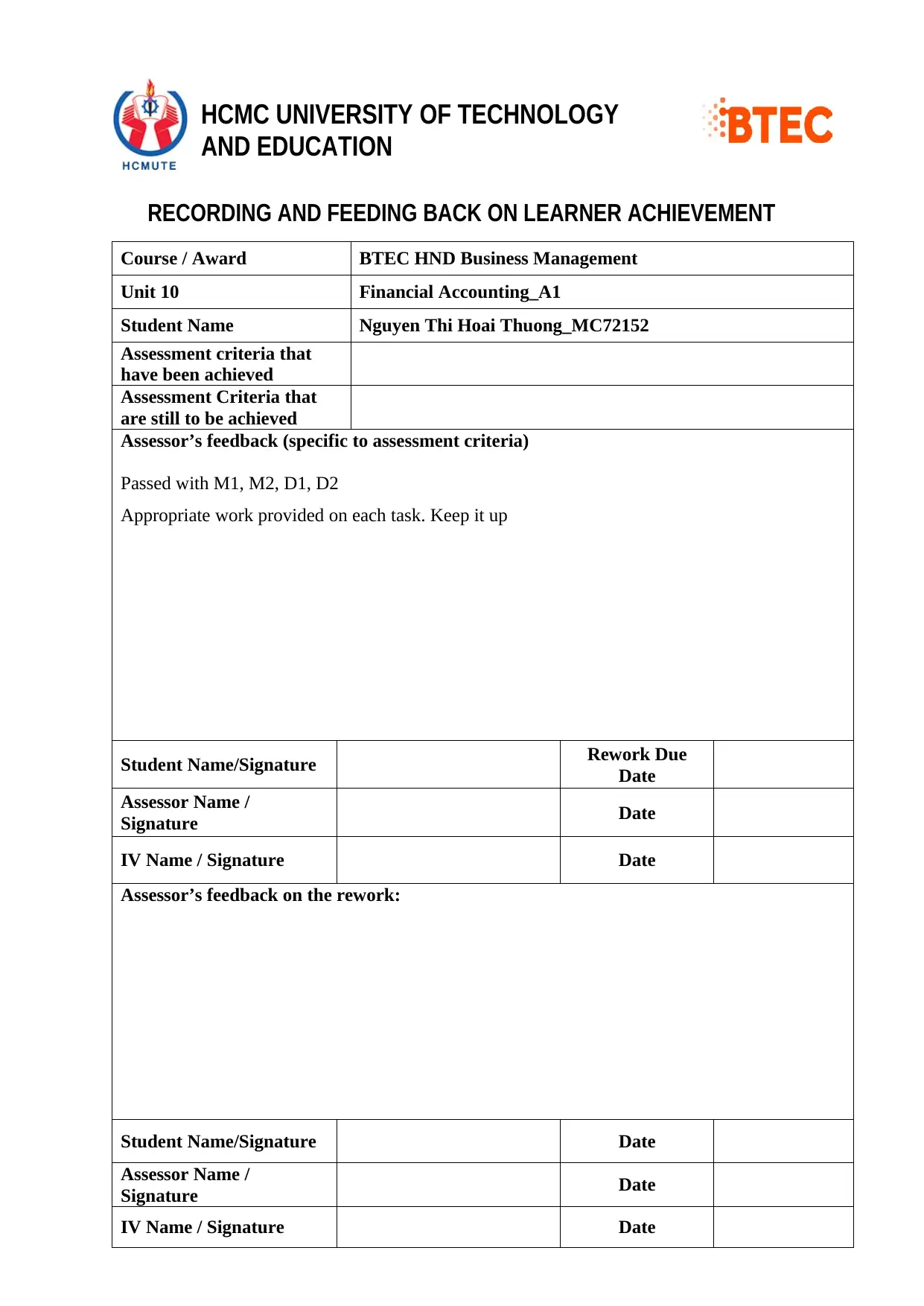
RECORDING AND FEEDING BACK ON LEARNER ACHIEVEMENT
Course / Award BTEC HND Business Management
Unit 10 Financial Accounting_A1
Student Name Nguyen Thi Hoai Thuong_MC72152
Assessment criteria that
have been achieved
Assessment Criteria that
are still to be achieved
Assessor’s feedback (specific to assessment criteria)
Passed with M1, M2, D1, D2
Appropriate work provided on each task. Keep it up
Student Name/Signature Rework Due
Date
Assessor Name /
Signature Date
IV Name / Signature Date
Assessor’s feedback on the rework:
Student Name/Signature Date
Assessor Name /
Signature Date
IV Name / Signature Date
HCMC UNIVERSITY OF TECHNOLOGY
AND EDUCATION
Course / Award BTEC HND Business Management
Unit 10 Financial Accounting_A1
Student Name Nguyen Thi Hoai Thuong_MC72152
Assessment criteria that
have been achieved
Assessment Criteria that
are still to be achieved
Assessor’s feedback (specific to assessment criteria)
Passed with M1, M2, D1, D2
Appropriate work provided on each task. Keep it up
Student Name/Signature Rework Due
Date
Assessor Name /
Signature Date
IV Name / Signature Date
Assessor’s feedback on the rework:
Student Name/Signature Date
Assessor Name /
Signature Date
IV Name / Signature Date
HCMC UNIVERSITY OF TECHNOLOGY
AND EDUCATION
Paraphrase This Document
Need a fresh take? Get an instant paraphrase of this document with our AI Paraphraser
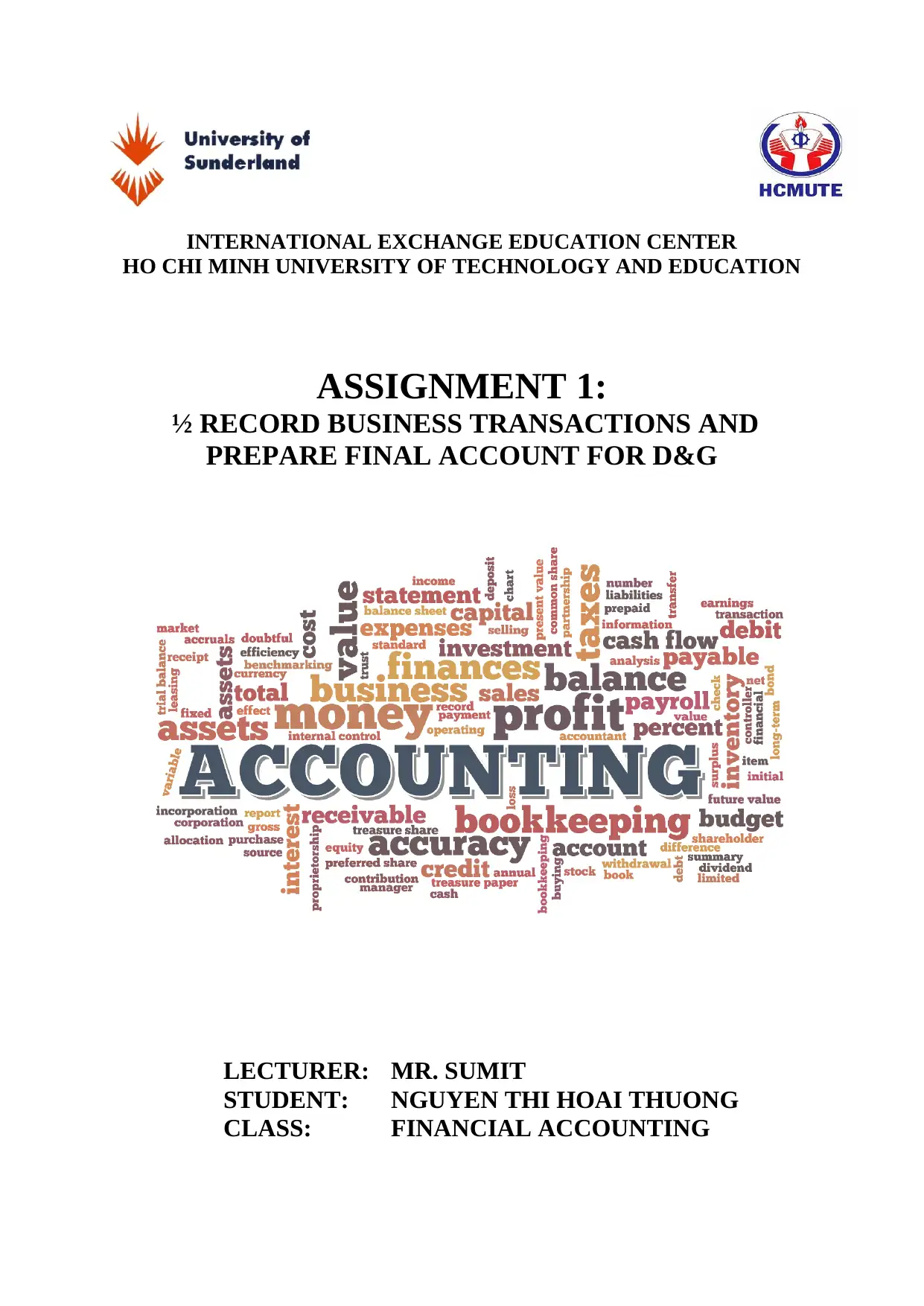
INTERNATIONAL EXCHANGE EDUCATION CENTER
HO CHI MINH UNIVERSITY OF TECHNOLOGY AND EDUCATION
ASSIGNMENT 1:
½ RECORD BUSINESS TRANSACTIONS AND
PREPARE FINAL ACCOUNT FOR D&G
LECTURER: MR. SUMIT
STUDENT: NGUYEN THI HOAI THUONG
CLASS: FINANCIAL ACCOUNTING
HO CHI MINH UNIVERSITY OF TECHNOLOGY AND EDUCATION
ASSIGNMENT 1:
½ RECORD BUSINESS TRANSACTIONS AND
PREPARE FINAL ACCOUNT FOR D&G
LECTURER: MR. SUMIT
STUDENT: NGUYEN THI HOAI THUONG
CLASS: FINANCIAL ACCOUNTING
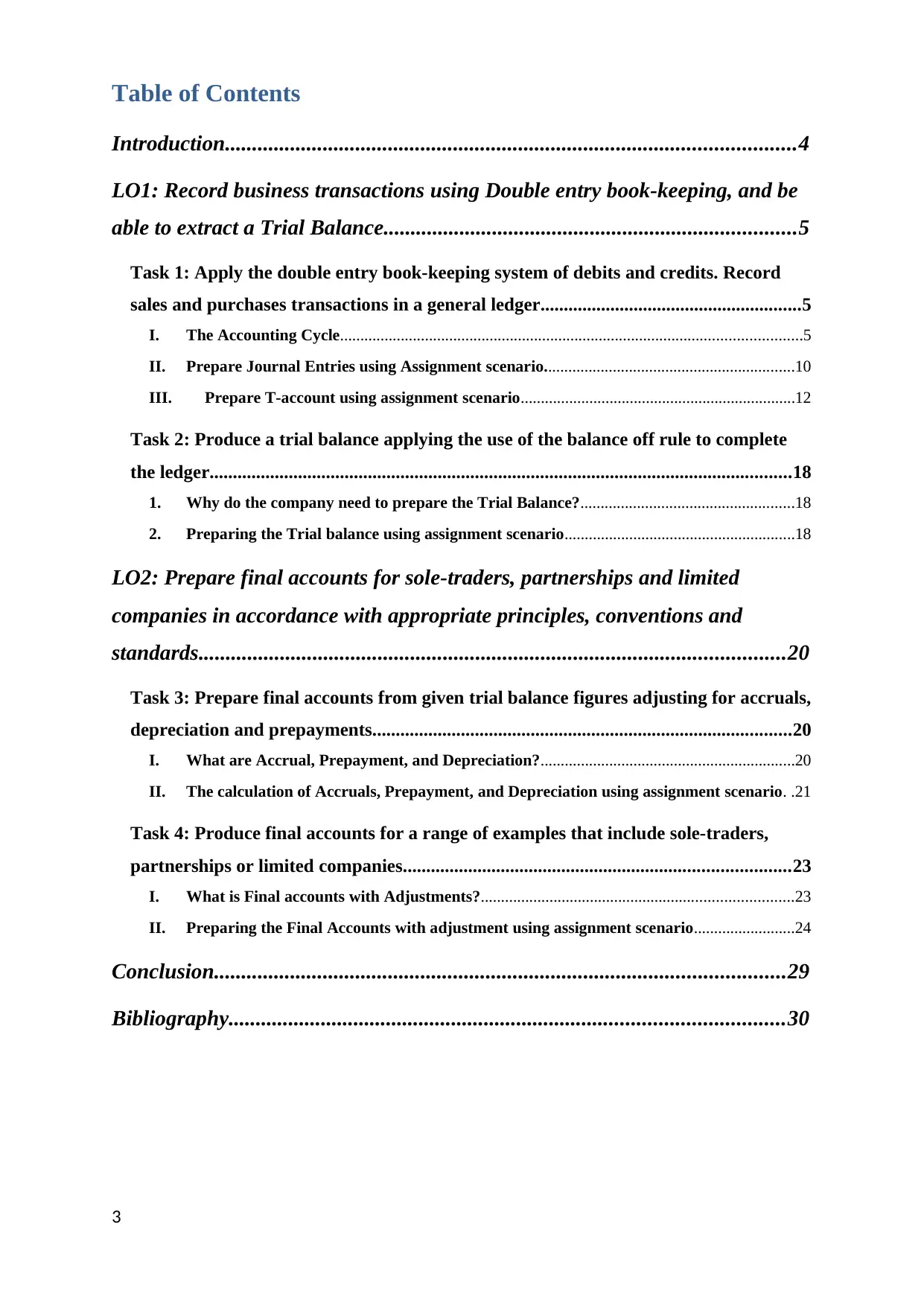
Table of Contents
Introduction.........................................................................................................4
LO1: Record business transactions using Double entry book-keeping, and be
able to extract a Trial Balance............................................................................5
Task 1: Apply the double entry book-keeping system of debits and credits. Record
sales and purchases transactions in a general ledger........................................................5
I. The Accounting Cycle..................................................................................................................5
II. Prepare Journal Entries using Assignment scenario..............................................................10
III. Prepare T-account using assignment scenario....................................................................12
Task 2: Produce a trial balance applying the use of the balance off rule to complete
the ledger.............................................................................................................................18
1. Why do the company need to prepare the Trial Balance?.....................................................18
2. Preparing the Trial balance using assignment scenario.........................................................18
LO2: Prepare final accounts for sole-traders, partnerships and limited
companies in accordance with appropriate principles, conventions and
standards............................................................................................................20
Task 3: Prepare final accounts from given trial balance figures adjusting for accruals,
depreciation and prepayments..........................................................................................20
I. What are Accrual, Prepayment, and Depreciation?...............................................................20
II. The calculation of Accruals, Prepayment, and Depreciation using assignment scenario. .21
Task 4: Produce final accounts for a range of examples that include sole-traders,
partnerships or limited companies...................................................................................23
I. What is Final accounts with Adjustments?.............................................................................23
II. Preparing the Final Accounts with adjustment using assignment scenario.........................24
Conclusion.........................................................................................................29
Bibliography......................................................................................................30
3
Introduction.........................................................................................................4
LO1: Record business transactions using Double entry book-keeping, and be
able to extract a Trial Balance............................................................................5
Task 1: Apply the double entry book-keeping system of debits and credits. Record
sales and purchases transactions in a general ledger........................................................5
I. The Accounting Cycle..................................................................................................................5
II. Prepare Journal Entries using Assignment scenario..............................................................10
III. Prepare T-account using assignment scenario....................................................................12
Task 2: Produce a trial balance applying the use of the balance off rule to complete
the ledger.............................................................................................................................18
1. Why do the company need to prepare the Trial Balance?.....................................................18
2. Preparing the Trial balance using assignment scenario.........................................................18
LO2: Prepare final accounts for sole-traders, partnerships and limited
companies in accordance with appropriate principles, conventions and
standards............................................................................................................20
Task 3: Prepare final accounts from given trial balance figures adjusting for accruals,
depreciation and prepayments..........................................................................................20
I. What are Accrual, Prepayment, and Depreciation?...............................................................20
II. The calculation of Accruals, Prepayment, and Depreciation using assignment scenario. .21
Task 4: Produce final accounts for a range of examples that include sole-traders,
partnerships or limited companies...................................................................................23
I. What is Final accounts with Adjustments?.............................................................................23
II. Preparing the Final Accounts with adjustment using assignment scenario.........................24
Conclusion.........................................................................................................29
Bibliography......................................................................................................30
3
⊘ This is a preview!⊘
Do you want full access?
Subscribe today to unlock all pages.

Trusted by 1+ million students worldwide
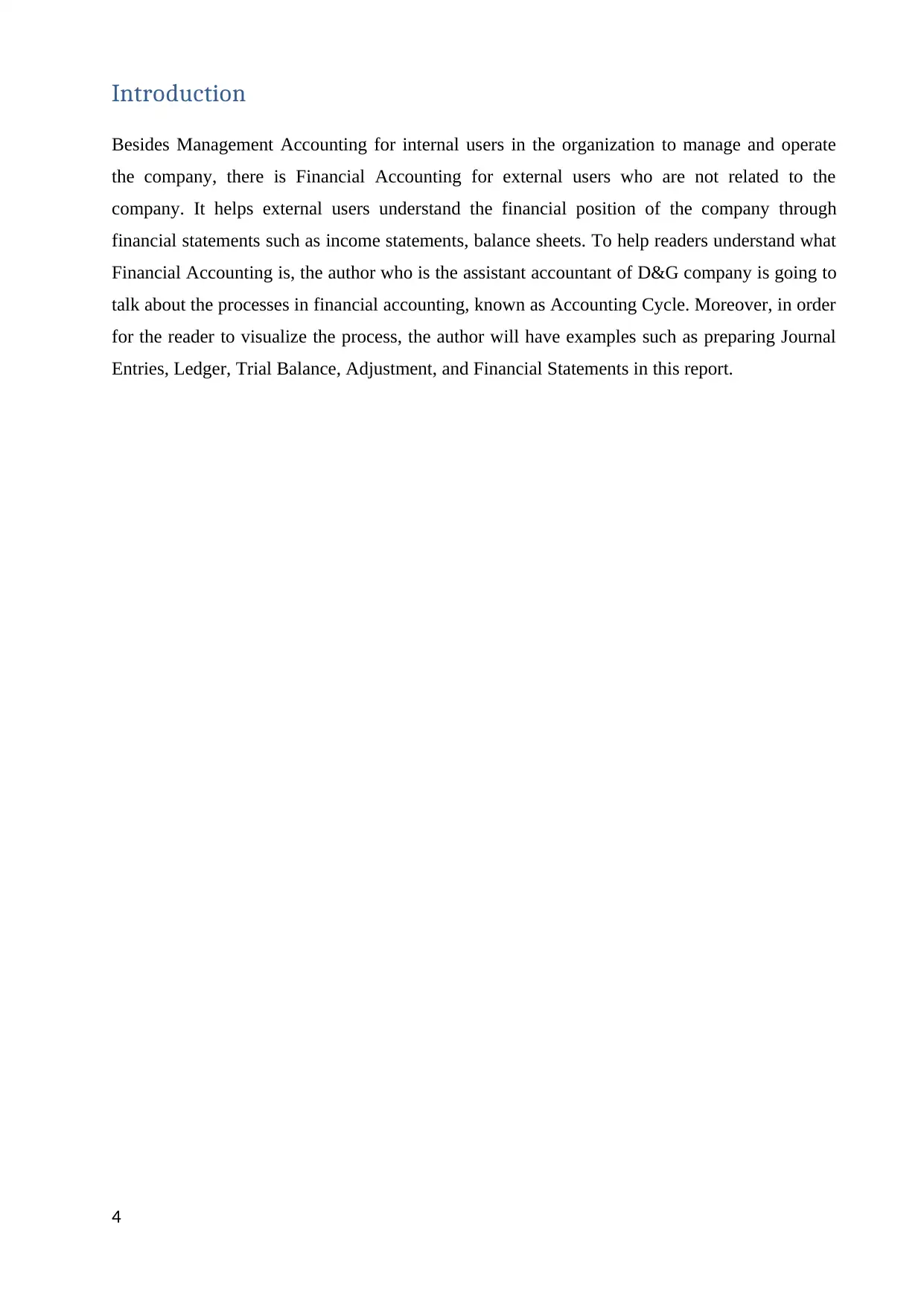
Introduction
Besides Management Accounting for internal users in the organization to manage and operate
the company, there is Financial Accounting for external users who are not related to the
company. It helps external users understand the financial position of the company through
financial statements such as income statements, balance sheets. To help readers understand what
Financial Accounting is, the author who is the assistant accountant of D&G company is going to
talk about the processes in financial accounting, known as Accounting Cycle. Moreover, in order
for the reader to visualize the process, the author will have examples such as preparing Journal
Entries, Ledger, Trial Balance, Adjustment, and Financial Statements in this report.
4
Besides Management Accounting for internal users in the organization to manage and operate
the company, there is Financial Accounting for external users who are not related to the
company. It helps external users understand the financial position of the company through
financial statements such as income statements, balance sheets. To help readers understand what
Financial Accounting is, the author who is the assistant accountant of D&G company is going to
talk about the processes in financial accounting, known as Accounting Cycle. Moreover, in order
for the reader to visualize the process, the author will have examples such as preparing Journal
Entries, Ledger, Trial Balance, Adjustment, and Financial Statements in this report.
4
Paraphrase This Document
Need a fresh take? Get an instant paraphrase of this document with our AI Paraphraser
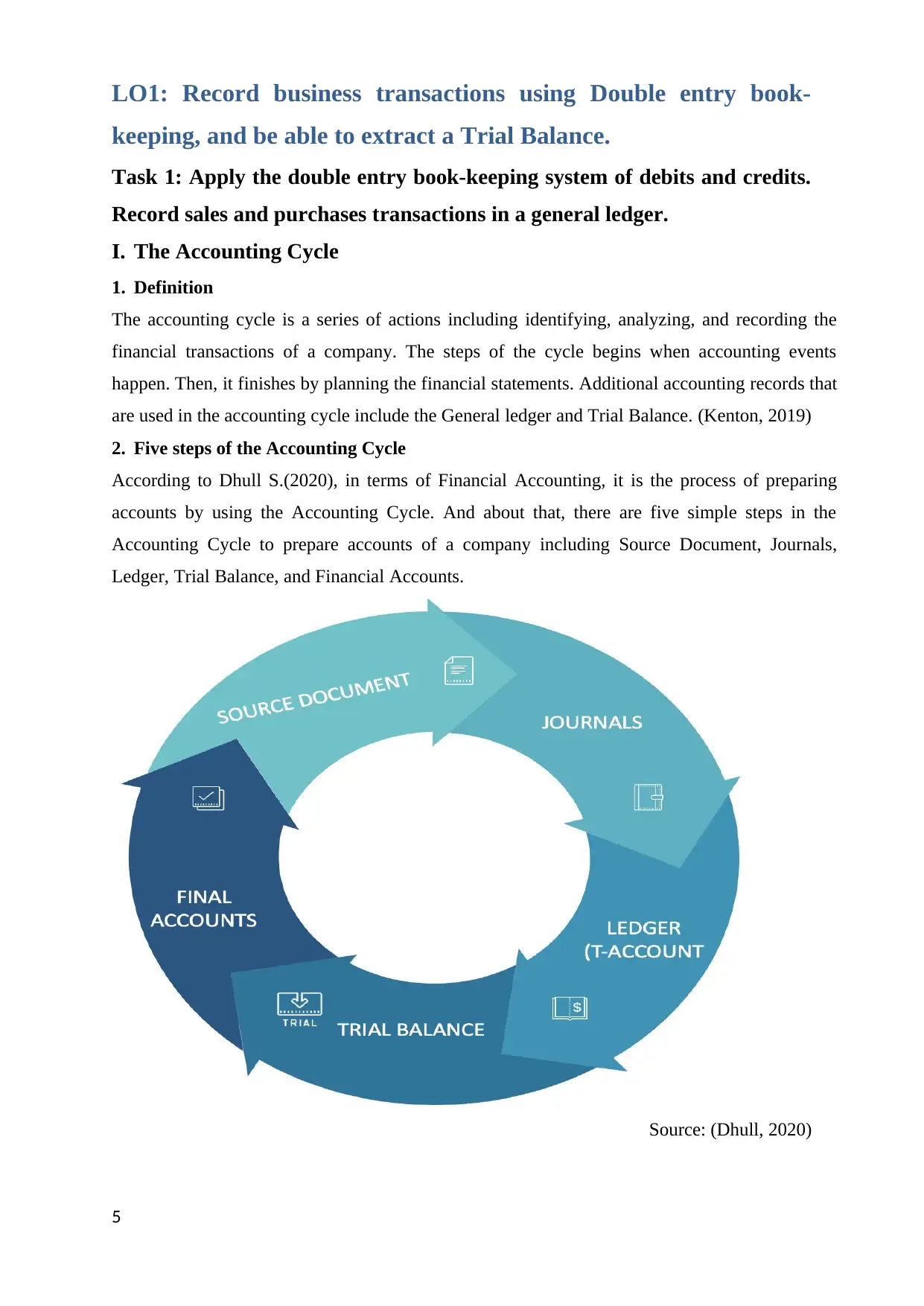
LO1: Record business transactions using Double entry book-
keeping, and be able to extract a Trial Balance.
Task 1: Apply the double entry book-keeping system of debits and credits.
Record sales and purchases transactions in a general ledger.
I. The Accounting Cycle
1. Definition
The accounting cycle is a series of actions including identifying, analyzing, and recording the
financial transactions of a company. The steps of the cycle begins when accounting events
happen. Then, it finishes by planning the financial statements. Additional accounting records that
are used in the accounting cycle include the General ledger and Trial Balance. (Kenton, 2019)
2. Five steps of the Accounting Cycle
According to Dhull S.(2020), in terms of Financial Accounting, it is the process of preparing
accounts by using the Accounting Cycle. And about that, there are five simple steps in the
Accounting Cycle to prepare accounts of a company including Source Document, Journals,
Ledger, Trial Balance, and Financial Accounts.
Source: (Dhull, 2020)
5
keeping, and be able to extract a Trial Balance.
Task 1: Apply the double entry book-keeping system of debits and credits.
Record sales and purchases transactions in a general ledger.
I. The Accounting Cycle
1. Definition
The accounting cycle is a series of actions including identifying, analyzing, and recording the
financial transactions of a company. The steps of the cycle begins when accounting events
happen. Then, it finishes by planning the financial statements. Additional accounting records that
are used in the accounting cycle include the General ledger and Trial Balance. (Kenton, 2019)
2. Five steps of the Accounting Cycle
According to Dhull S.(2020), in terms of Financial Accounting, it is the process of preparing
accounts by using the Accounting Cycle. And about that, there are five simple steps in the
Accounting Cycle to prepare accounts of a company including Source Document, Journals,
Ledger, Trial Balance, and Financial Accounts.
Source: (Dhull, 2020)
5
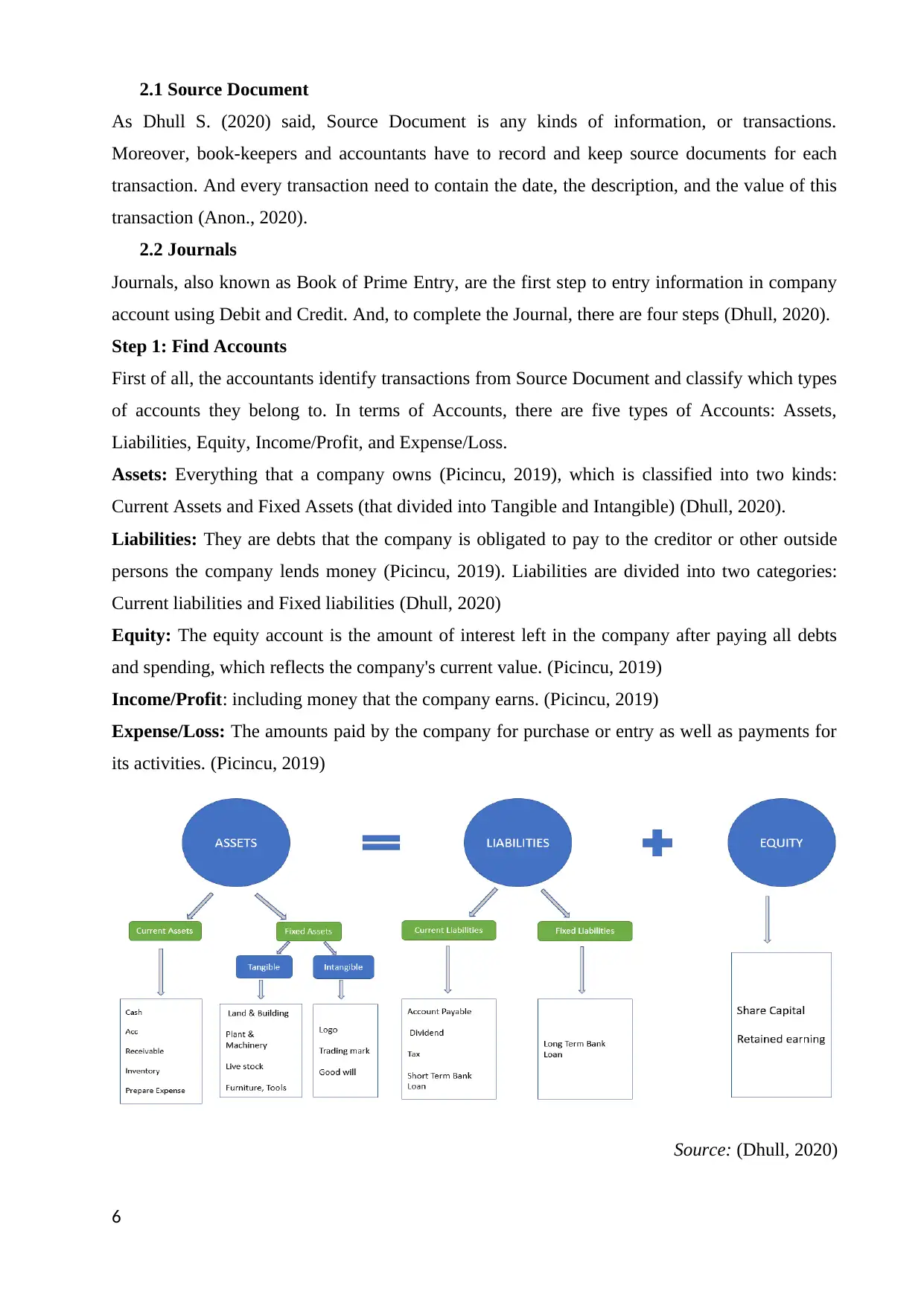
2.1 Source Document
As Dhull S. (2020) said, Source Document is any kinds of information, or transactions.
Moreover, book-keepers and accountants have to record and keep source documents for each
transaction. And every transaction need to contain the date, the description, and the value of this
transaction (Anon., 2020).
2.2 Journals
Journals, also known as Book of Prime Entry, are the first step to entry information in company
account using Debit and Credit. And, to complete the Journal, there are four steps (Dhull, 2020).
Step 1: Find Accounts
First of all, the accountants identify transactions from Source Document and classify which types
of accounts they belong to. In terms of Accounts, there are five types of Accounts: Assets,
Liabilities, Equity, Income/Profit, and Expense/Loss.
Assets: Everything that a company owns (Picincu, 2019), which is classified into two kinds:
Current Assets and Fixed Assets (that divided into Tangible and Intangible) (Dhull, 2020).
Liabilities: They are debts that the company is obligated to pay to the creditor or other outside
persons the company lends money (Picincu, 2019). Liabilities are divided into two categories:
Current liabilities and Fixed liabilities (Dhull, 2020)
Equity: The equity account is the amount of interest left in the company after paying all debts
and spending, which reflects the company's current value. (Picincu, 2019)
Income/Profit: including money that the company earns. (Picincu, 2019)
Expense/Loss: The amounts paid by the company for purchase or entry as well as payments for
its activities. (Picincu, 2019)
Source: (Dhull, 2020)
6
As Dhull S. (2020) said, Source Document is any kinds of information, or transactions.
Moreover, book-keepers and accountants have to record and keep source documents for each
transaction. And every transaction need to contain the date, the description, and the value of this
transaction (Anon., 2020).
2.2 Journals
Journals, also known as Book of Prime Entry, are the first step to entry information in company
account using Debit and Credit. And, to complete the Journal, there are four steps (Dhull, 2020).
Step 1: Find Accounts
First of all, the accountants identify transactions from Source Document and classify which types
of accounts they belong to. In terms of Accounts, there are five types of Accounts: Assets,
Liabilities, Equity, Income/Profit, and Expense/Loss.
Assets: Everything that a company owns (Picincu, 2019), which is classified into two kinds:
Current Assets and Fixed Assets (that divided into Tangible and Intangible) (Dhull, 2020).
Liabilities: They are debts that the company is obligated to pay to the creditor or other outside
persons the company lends money (Picincu, 2019). Liabilities are divided into two categories:
Current liabilities and Fixed liabilities (Dhull, 2020)
Equity: The equity account is the amount of interest left in the company after paying all debts
and spending, which reflects the company's current value. (Picincu, 2019)
Income/Profit: including money that the company earns. (Picincu, 2019)
Expense/Loss: The amounts paid by the company for purchase or entry as well as payments for
its activities. (Picincu, 2019)
Source: (Dhull, 2020)
6
⊘ This is a preview!⊘
Do you want full access?
Subscribe today to unlock all pages.

Trusted by 1+ million students worldwide
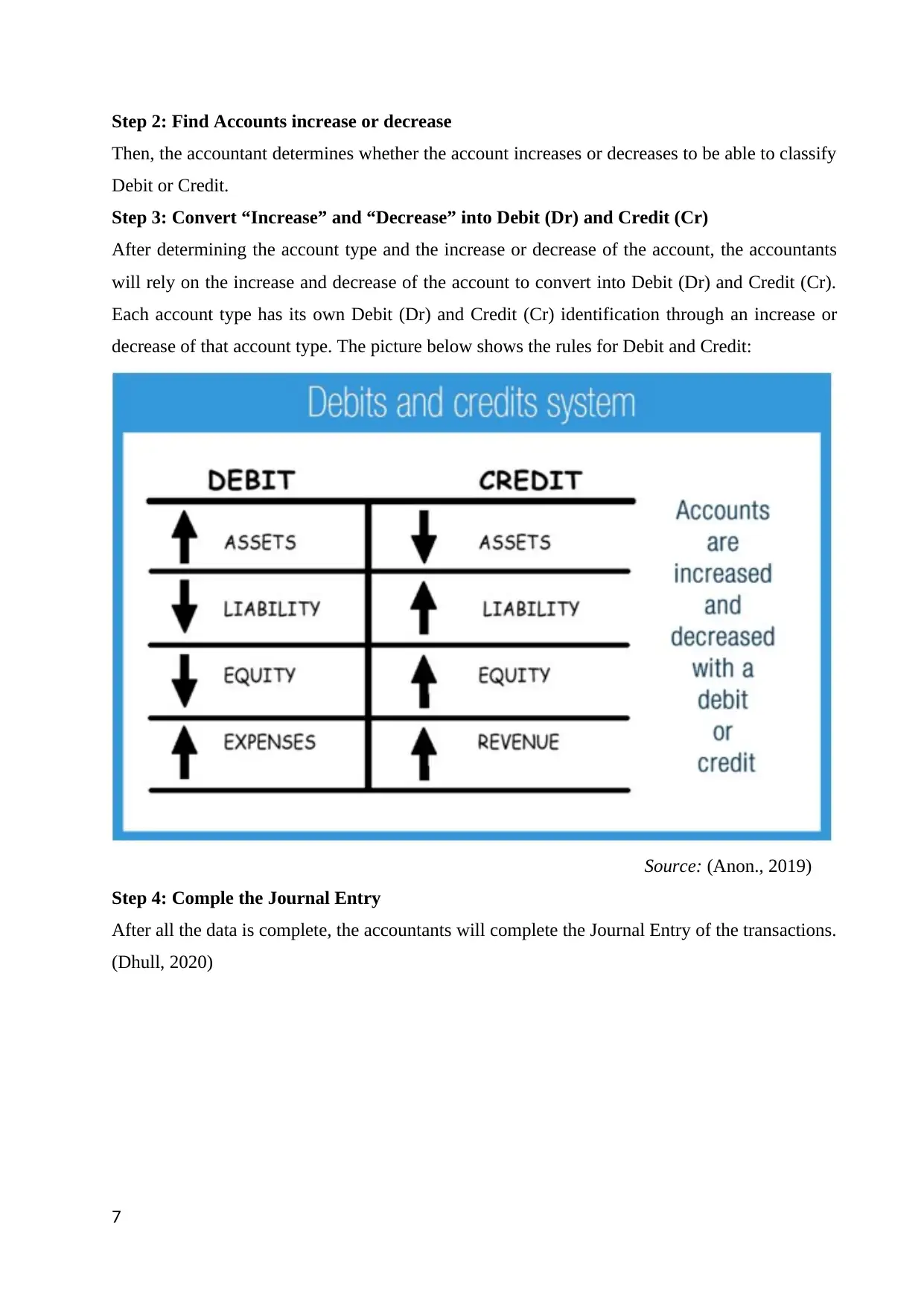
Step 2: Find Accounts increase or decrease
Then, the accountant determines whether the account increases or decreases to be able to classify
Debit or Credit.
Step 3: Convert “Increase” and “Decrease” into Debit (Dr) and Credit (Cr)
After determining the account type and the increase or decrease of the account, the accountants
will rely on the increase and decrease of the account to convert into Debit (Dr) and Credit (Cr).
Each account type has its own Debit (Dr) and Credit (Cr) identification through an increase or
decrease of that account type. The picture below shows the rules for Debit and Credit:
Source: (Anon., 2019)
Step 4: Comple the Journal Entry
After all the data is complete, the accountants will complete the Journal Entry of the transactions.
(Dhull, 2020)
7
Then, the accountant determines whether the account increases or decreases to be able to classify
Debit or Credit.
Step 3: Convert “Increase” and “Decrease” into Debit (Dr) and Credit (Cr)
After determining the account type and the increase or decrease of the account, the accountants
will rely on the increase and decrease of the account to convert into Debit (Dr) and Credit (Cr).
Each account type has its own Debit (Dr) and Credit (Cr) identification through an increase or
decrease of that account type. The picture below shows the rules for Debit and Credit:
Source: (Anon., 2019)
Step 4: Comple the Journal Entry
After all the data is complete, the accountants will complete the Journal Entry of the transactions.
(Dhull, 2020)
7
Paraphrase This Document
Need a fresh take? Get an instant paraphrase of this document with our AI Paraphraser
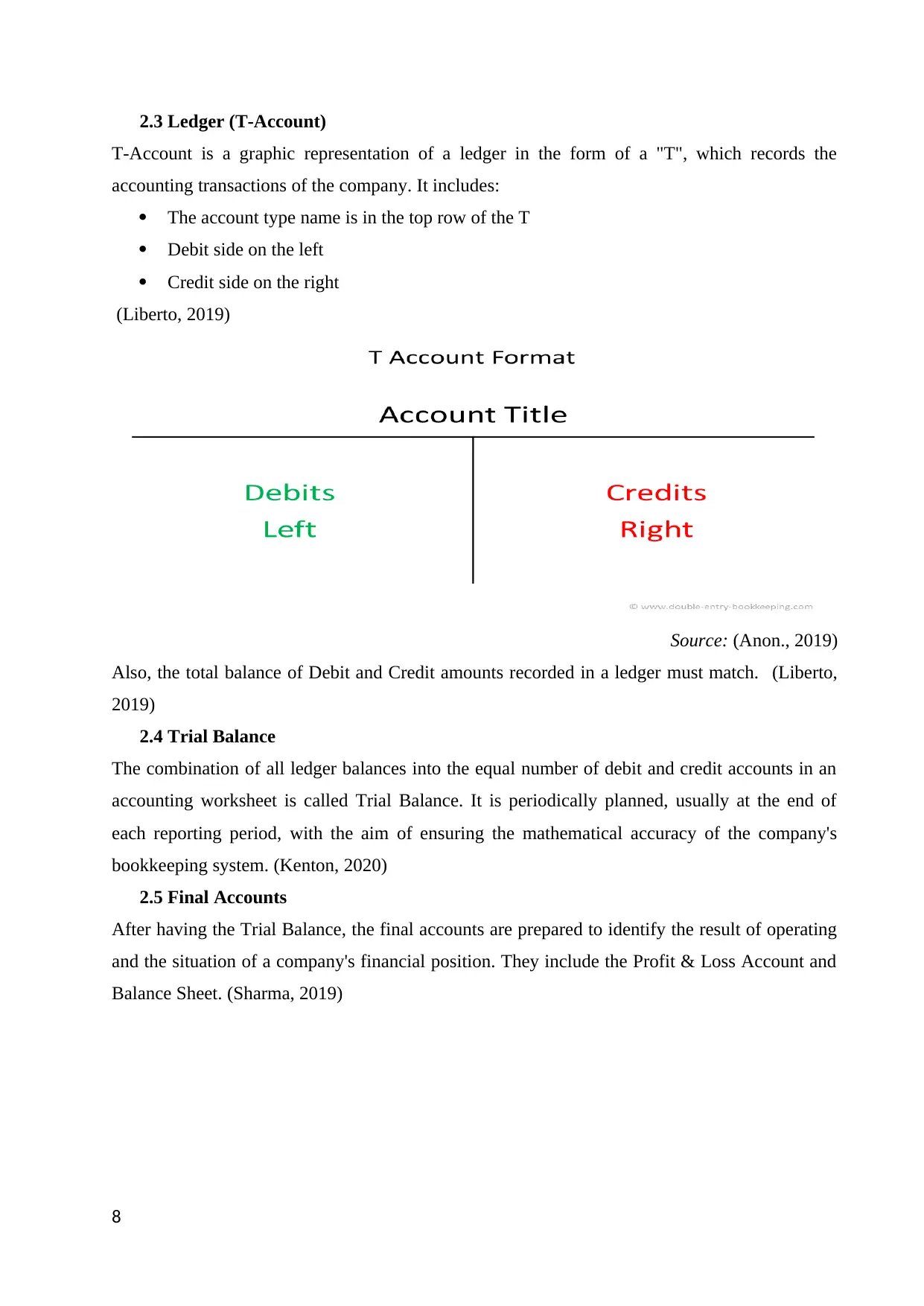
2.3 Ledger (T-Account)
T-Account is a graphic representation of a ledger in the form of a "T", which records the
accounting transactions of the company. It includes:
The account type name is in the top row of the T
Debit side on the left
Credit side on the right
(Liberto, 2019)
Source: (Anon., 2019)
Also, the total balance of Debit and Credit amounts recorded in a ledger must match. (Liberto,
2019)
2.4 Trial Balance
The combination of all ledger balances into the equal number of debit and credit accounts in an
accounting worksheet is called Trial Balance. It is periodically planned, usually at the end of
each reporting period, with the aim of ensuring the mathematical accuracy of the company's
bookkeeping system. (Kenton, 2020)
2.5 Final Accounts
After having the Trial Balance, the final accounts are prepared to identify the result of operating
and the situation of a company's financial position. They include the Profit & Loss Account and
Balance Sheet. (Sharma, 2019)
8
T-Account is a graphic representation of a ledger in the form of a "T", which records the
accounting transactions of the company. It includes:
The account type name is in the top row of the T
Debit side on the left
Credit side on the right
(Liberto, 2019)
Source: (Anon., 2019)
Also, the total balance of Debit and Credit amounts recorded in a ledger must match. (Liberto,
2019)
2.4 Trial Balance
The combination of all ledger balances into the equal number of debit and credit accounts in an
accounting worksheet is called Trial Balance. It is periodically planned, usually at the end of
each reporting period, with the aim of ensuring the mathematical accuracy of the company's
bookkeeping system. (Kenton, 2020)
2.5 Final Accounts
After having the Trial Balance, the final accounts are prepared to identify the result of operating
and the situation of a company's financial position. They include the Profit & Loss Account and
Balance Sheet. (Sharma, 2019)
8
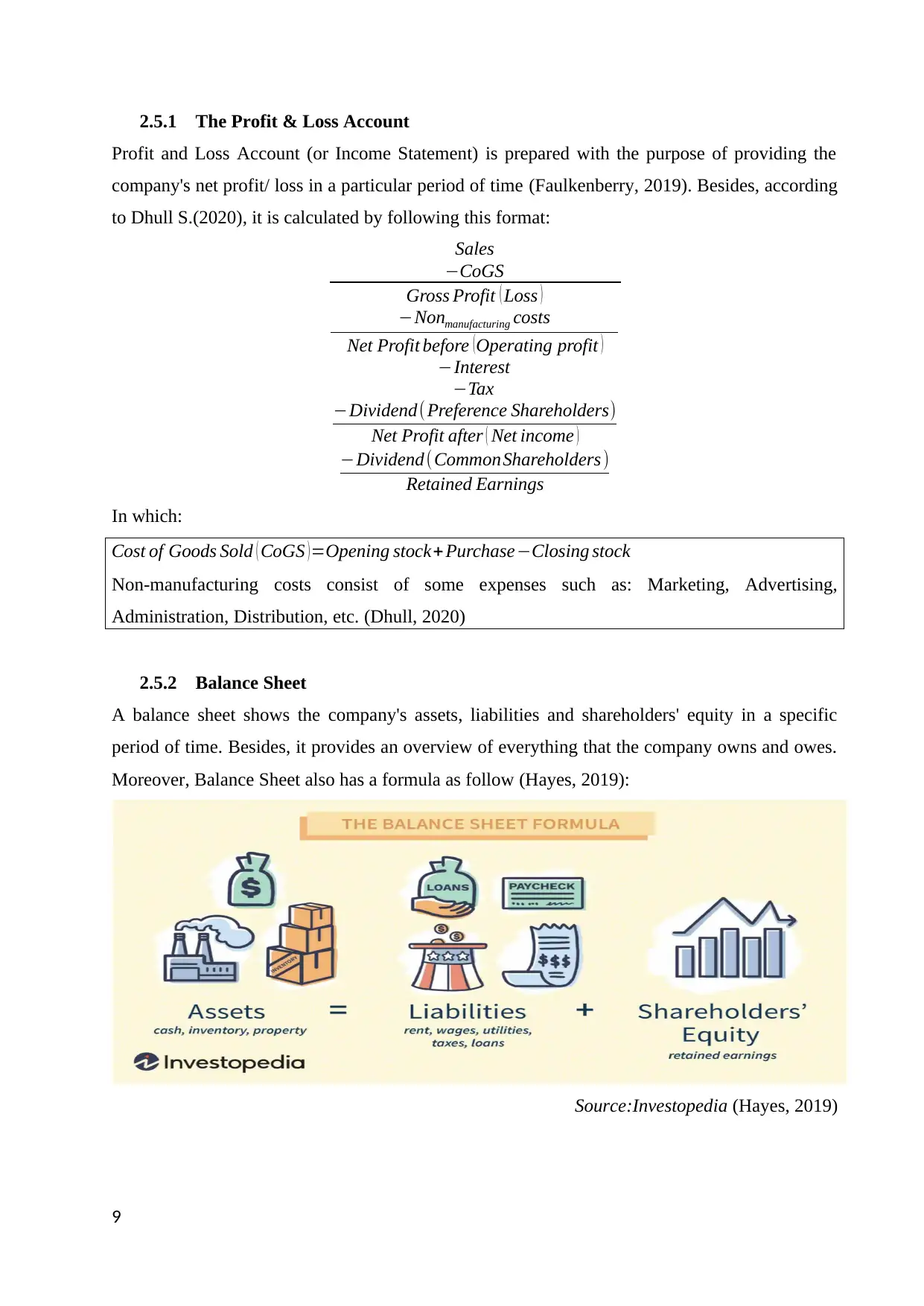
2.5.1 The Profit & Loss Account
Profit and Loss Account (or Income Statement) is prepared with the purpose of providing the
company's net profit/ loss in a particular period of time (Faulkenberry, 2019). Besides, according
to Dhull S.(2020), it is calculated by following this format:
Sales
−CoGS
Gross Profit ( Loss )
−Nonmanufacturing costs
Net Profit before (Operating profit )
−Interest
−Tax
−Dividend(Preference Shareholders)
Net Profit after ( Net income )
−Dividend(CommonShareholders)
Retained Earnings
In which:
Cost of Goods Sold ( CoGS ) =Opening stock+Purchase−Closing stock
Non-manufacturing costs consist of some expenses such as: Marketing, Advertising,
Administration, Distribution, etc. (Dhull, 2020)
2.5.2 Balance Sheet
A balance sheet shows the company's assets, liabilities and shareholders' equity in a specific
period of time. Besides, it provides an overview of everything that the company owns and owes.
Moreover, Balance Sheet also has a formula as follow (Hayes, 2019):
Source:Investopedia (Hayes, 2019)
9
Profit and Loss Account (or Income Statement) is prepared with the purpose of providing the
company's net profit/ loss in a particular period of time (Faulkenberry, 2019). Besides, according
to Dhull S.(2020), it is calculated by following this format:
Sales
−CoGS
Gross Profit ( Loss )
−Nonmanufacturing costs
Net Profit before (Operating profit )
−Interest
−Tax
−Dividend(Preference Shareholders)
Net Profit after ( Net income )
−Dividend(CommonShareholders)
Retained Earnings
In which:
Cost of Goods Sold ( CoGS ) =Opening stock+Purchase−Closing stock
Non-manufacturing costs consist of some expenses such as: Marketing, Advertising,
Administration, Distribution, etc. (Dhull, 2020)
2.5.2 Balance Sheet
A balance sheet shows the company's assets, liabilities and shareholders' equity in a specific
period of time. Besides, it provides an overview of everything that the company owns and owes.
Moreover, Balance Sheet also has a formula as follow (Hayes, 2019):
Source:Investopedia (Hayes, 2019)
9
⊘ This is a preview!⊘
Do you want full access?
Subscribe today to unlock all pages.

Trusted by 1+ million students worldwide
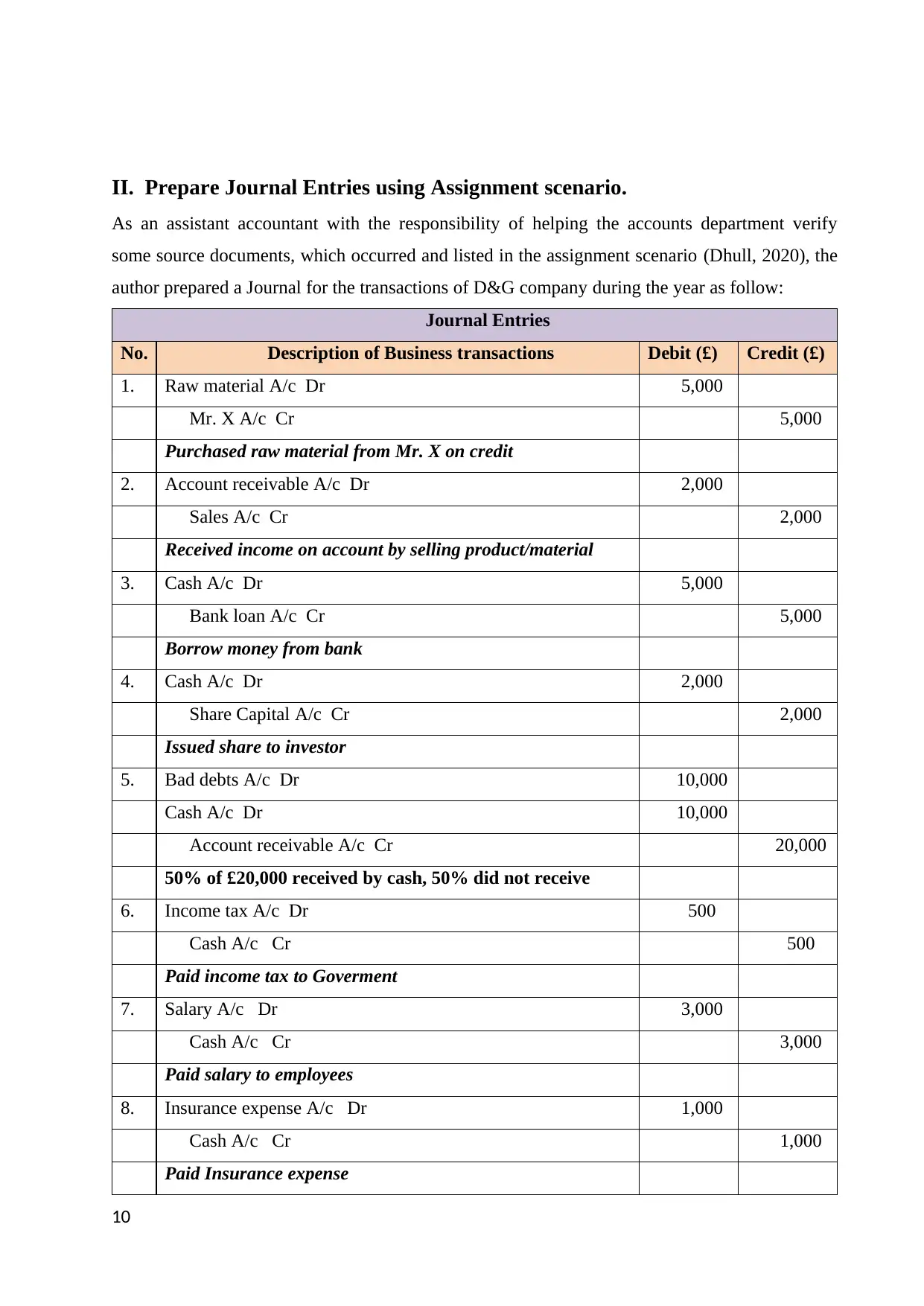
II. Prepare Journal Entries using Assignment scenario.
As an assistant accountant with the responsibility of helping the accounts department verify
some source documents, which occurred and listed in the assignment scenario (Dhull, 2020), the
author prepared a Journal for the transactions of D&G company during the year as follow:
Journal Entries
No. Description of Business transactions Debit (£) Credit (£)
1. Raw material A/c Dr 5,000
Mr. X A/c Cr 5,000
Purchased raw material from Mr. X on credit
2. Account receivable A/c Dr 2,000
Sales A/c Cr 2,000
Received income on account by selling product/material
3. Cash A/c Dr 5,000
Bank loan A/c Cr 5,000
Borrow money from bank
4. Cash A/c Dr 2,000
Share Capital A/c Cr 2,000
Issued share to investor
5. Bad debts A/c Dr 10,000
Cash A/c Dr 10,000
Account receivable A/c Cr 20,000
50% of £20,000 received by cash, 50% did not receive
6. Income tax A/c Dr 500
Cash A/c Cr 500
Paid income tax to Goverment
7. Salary A/c Dr 3,000
Cash A/c Cr 3,000
Paid salary to employees
8. Insurance expense A/c Dr 1,000
Cash A/c Cr 1,000
Paid Insurance expense
10
As an assistant accountant with the responsibility of helping the accounts department verify
some source documents, which occurred and listed in the assignment scenario (Dhull, 2020), the
author prepared a Journal for the transactions of D&G company during the year as follow:
Journal Entries
No. Description of Business transactions Debit (£) Credit (£)
1. Raw material A/c Dr 5,000
Mr. X A/c Cr 5,000
Purchased raw material from Mr. X on credit
2. Account receivable A/c Dr 2,000
Sales A/c Cr 2,000
Received income on account by selling product/material
3. Cash A/c Dr 5,000
Bank loan A/c Cr 5,000
Borrow money from bank
4. Cash A/c Dr 2,000
Share Capital A/c Cr 2,000
Issued share to investor
5. Bad debts A/c Dr 10,000
Cash A/c Dr 10,000
Account receivable A/c Cr 20,000
50% of £20,000 received by cash, 50% did not receive
6. Income tax A/c Dr 500
Cash A/c Cr 500
Paid income tax to Goverment
7. Salary A/c Dr 3,000
Cash A/c Cr 3,000
Paid salary to employees
8. Insurance expense A/c Dr 1,000
Cash A/c Cr 1,000
Paid Insurance expense
10
Paraphrase This Document
Need a fresh take? Get an instant paraphrase of this document with our AI Paraphraser
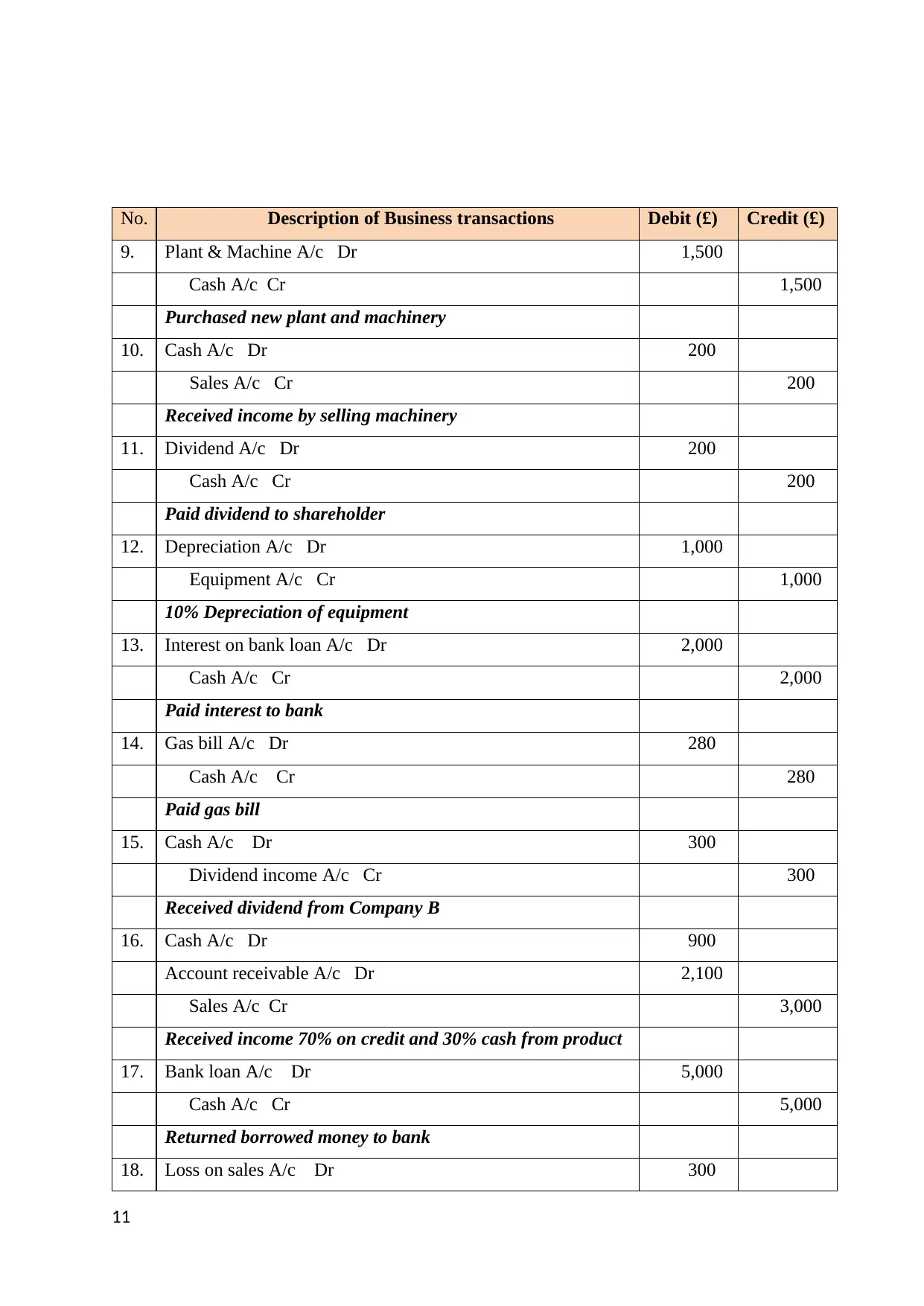
No. Description of Business transactions Debit (£) Credit (£)
9. Plant & Machine A/c Dr 1,500
Cash A/c Cr 1,500
Purchased new plant and machinery
10. Cash A/c Dr 200
Sales A/c Cr 200
Received income by selling machinery
11. Dividend A/c Dr 200
Cash A/c Cr 200
Paid dividend to shareholder
12. Depreciation A/c Dr 1,000
Equipment A/c Cr 1,000
10% Depreciation of equipment
13. Interest on bank loan A/c Dr 2,000
Cash A/c Cr 2,000
Paid interest to bank
14. Gas bill A/c Dr 280
Cash A/c Cr 280
Paid gas bill
15. Cash A/c Dr 300
Dividend income A/c Cr 300
Received dividend from Company B
16. Cash A/c Dr 900
Account receivable A/c Dr 2,100
Sales A/c Cr 3,000
Received income 70% on credit and 30% cash from product
17. Bank loan A/c Dr 5,000
Cash A/c Cr 5,000
Returned borrowed money to bank
18. Loss on sales A/c Dr 300
11
9. Plant & Machine A/c Dr 1,500
Cash A/c Cr 1,500
Purchased new plant and machinery
10. Cash A/c Dr 200
Sales A/c Cr 200
Received income by selling machinery
11. Dividend A/c Dr 200
Cash A/c Cr 200
Paid dividend to shareholder
12. Depreciation A/c Dr 1,000
Equipment A/c Cr 1,000
10% Depreciation of equipment
13. Interest on bank loan A/c Dr 2,000
Cash A/c Cr 2,000
Paid interest to bank
14. Gas bill A/c Dr 280
Cash A/c Cr 280
Paid gas bill
15. Cash A/c Dr 300
Dividend income A/c Cr 300
Received dividend from Company B
16. Cash A/c Dr 900
Account receivable A/c Dr 2,100
Sales A/c Cr 3,000
Received income 70% on credit and 30% cash from product
17. Bank loan A/c Dr 5,000
Cash A/c Cr 5,000
Returned borrowed money to bank
18. Loss on sales A/c Dr 300
11
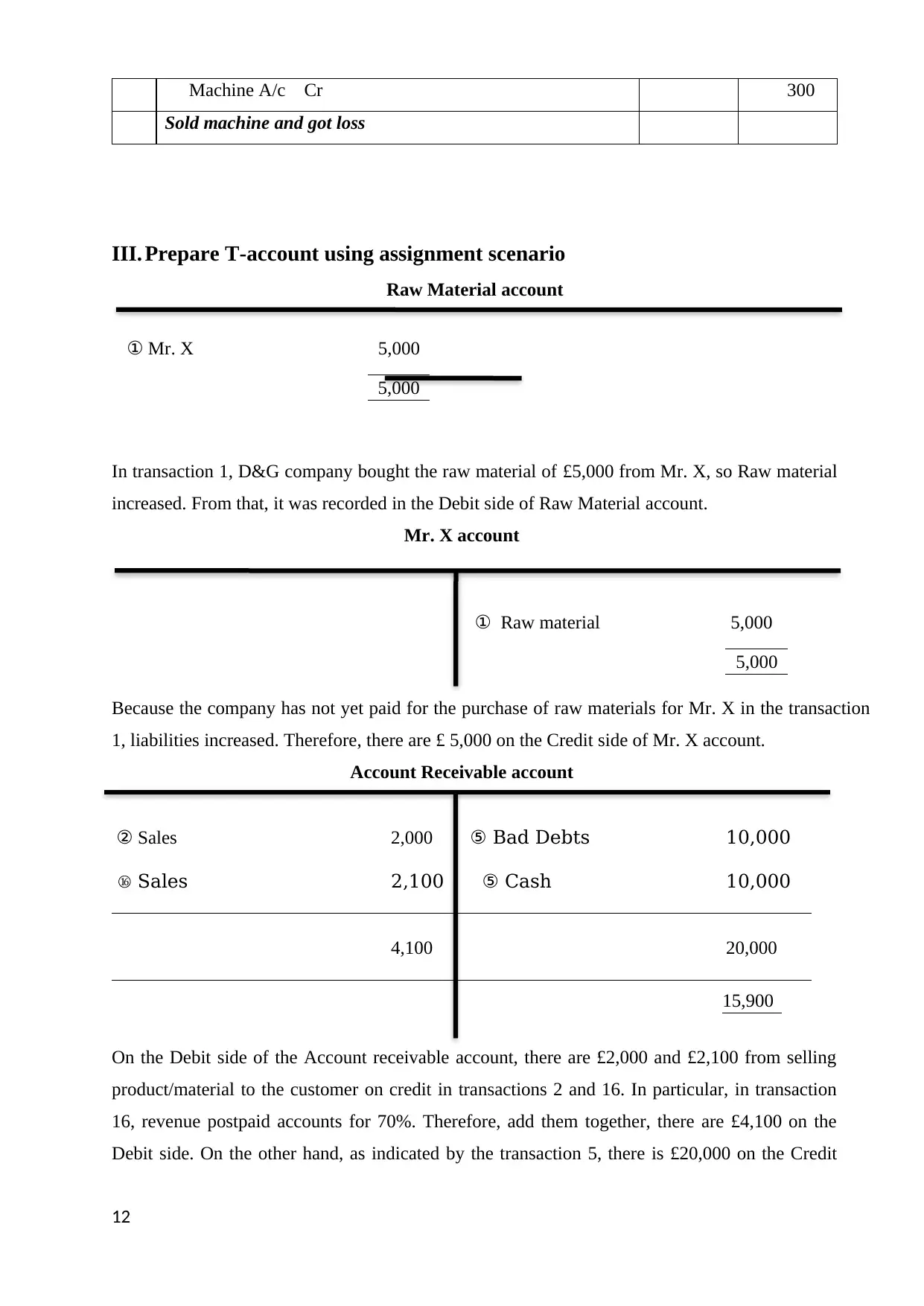
Machine A/c Cr 300
Sold machine and got loss
III. Prepare T-account using assignment scenario
Raw Material account
In transaction 1, D&G company bought the raw material of £5,000 from Mr. X, so Raw material
increased. From that, it was recorded in the Debit side of Raw Material account.
Mr. X account
① Raw material 5,000
Because the company has not yet paid for the purchase of raw materials for Mr. X in the transaction
1, liabilities increased. Therefore, there are £ 5,000 on the Credit side of Mr. X account.
Account Receivable account
② Sales 2,000 ⑤ Bad Debts 10,000
Sales⑯ 2,100 ⑤ Cash 10,000
4,100 20,000
On the Debit side of the Account receivable account, there are £2,000 and £2,100 from selling
product/material to the customer on credit in transactions 2 and 16. In particular, in transaction
16, revenue postpaid accounts for 70%. Therefore, add them together, there are £4,100 on the
Debit side. On the other hand, as indicated by the transaction 5, there is £20,000 on the Credit
12
① Mr. X 5,000
5,000
5,000
15,900
Sold machine and got loss
III. Prepare T-account using assignment scenario
Raw Material account
In transaction 1, D&G company bought the raw material of £5,000 from Mr. X, so Raw material
increased. From that, it was recorded in the Debit side of Raw Material account.
Mr. X account
① Raw material 5,000
Because the company has not yet paid for the purchase of raw materials for Mr. X in the transaction
1, liabilities increased. Therefore, there are £ 5,000 on the Credit side of Mr. X account.
Account Receivable account
② Sales 2,000 ⑤ Bad Debts 10,000
Sales⑯ 2,100 ⑤ Cash 10,000
4,100 20,000
On the Debit side of the Account receivable account, there are £2,000 and £2,100 from selling
product/material to the customer on credit in transactions 2 and 16. In particular, in transaction
16, revenue postpaid accounts for 70%. Therefore, add them together, there are £4,100 on the
Debit side. On the other hand, as indicated by the transaction 5, there is £20,000 on the Credit
12
① Mr. X 5,000
5,000
5,000
15,900
⊘ This is a preview!⊘
Do you want full access?
Subscribe today to unlock all pages.

Trusted by 1+ million students worldwide
1 out of 33
Related Documents
Your All-in-One AI-Powered Toolkit for Academic Success.
+13062052269
info@desklib.com
Available 24*7 on WhatsApp / Email
![[object Object]](/_next/static/media/star-bottom.7253800d.svg)
Unlock your academic potential
Copyright © 2020–2025 A2Z Services. All Rights Reserved. Developed and managed by ZUCOL.





